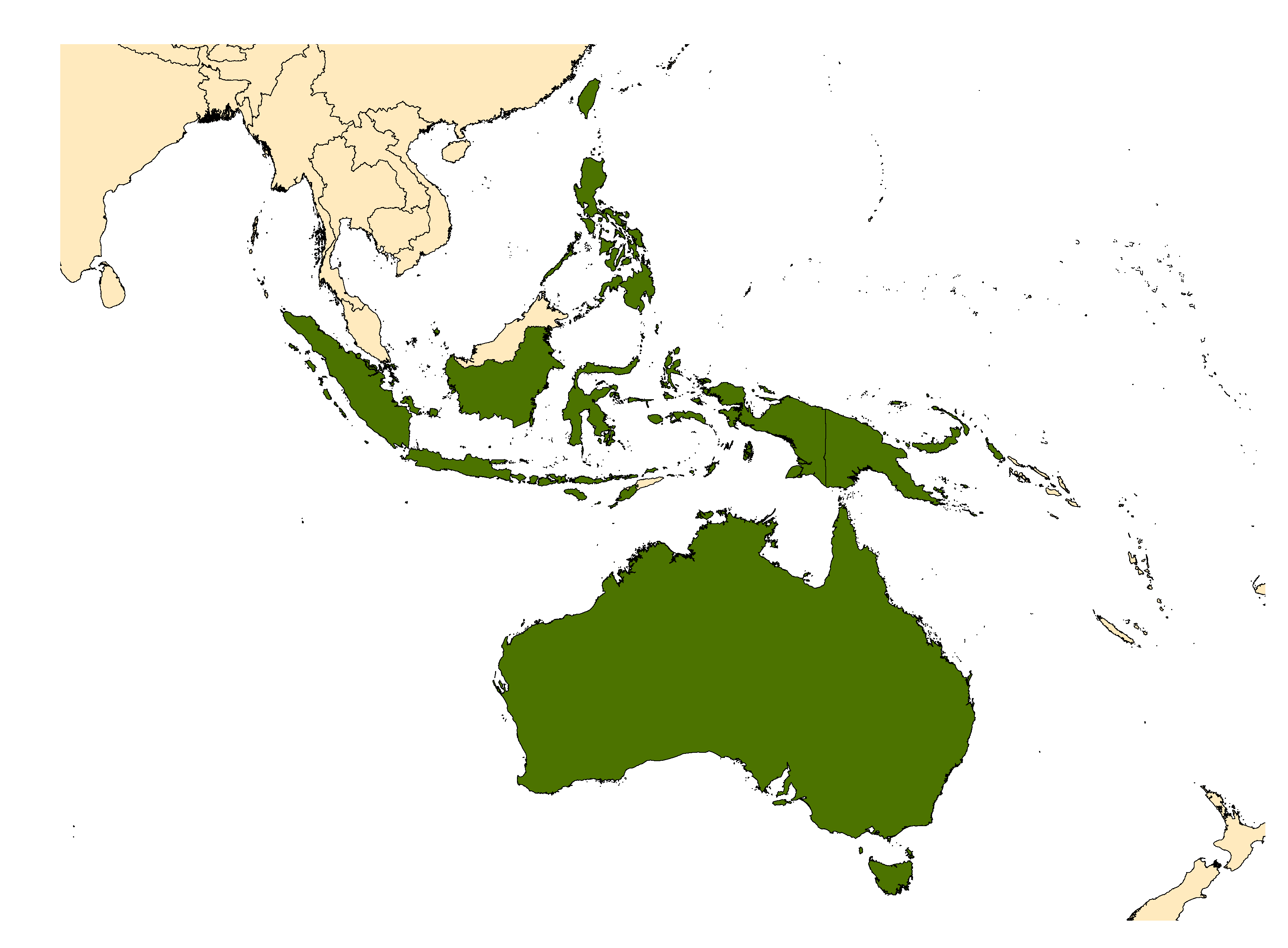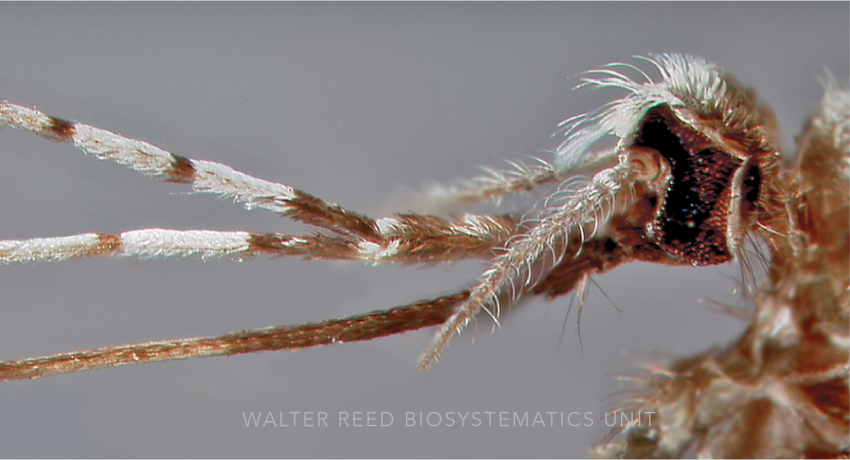AUSTRALASIAN REGION
Etymology: ringed feet (L); tarsi
The banded legs and dominantly white palps of Anopheles annulipes are highly distinctive, with the leg bands seemingly more widely spread the further away from the body they are. Molecular analysis of An. annulipes s.l. indicates the presence of 17 cryptic taxa (An. annulipes A–Q), making this the most speciose cryptic species group uncovered within mosquitoes to date. These putative species belong to two major geographical clades (north and south), suggesting that climate was a strong driver of species radiation in the Annulipes Complex. Five synonyms of An. annulipes are currently recognized—musivus Skuse and mastersi Skuse from New South Wales, Australia, and perplexus Taylor, persimilis Taylor, and derricki Taylor from Queensland, Australia. Efforts are desperately needed to formally describe the composite taxa within this important group of malaria vectors.
Type locality: Van Diemen’s Land [Tasmania], Australia
Type depository: Natural History Museum, London, England, United Kingdom (NHMUK)
DIAGNOSTIC CHARACTERS (Click photos to view; mouse over and click large photo to zoom in.)
ADULT (illustrated): Head: Antenna not variably colored; MPlp3 never divided apically by a black band; MPlp5 dark basally. Thorax: Scutum with scales on lateral areas; capitellum of haltere black-scaled dorsally; Legs: Ta-I2-5 and Ta-II2-5 banded or spotted. Wing: Many dark spots on wing, with ≥4 on CuA and 1A.
LARVA (not illustrated): Head: Seta 1-A very small, inconspicuous; seta 2-C smooth or weakly aciculate; seta 3-C at most 0.75 x length of seta 2-C ≥6, sometimes highly-branched; seta 4-C about 0.25 x length of seta 2-C; seta 4-C always strongly branched from near the base; setae 5,6-C plumose. Thorax: Seta 1,2-P on separate or fused tubercles; setae 9–12-P,M,T single. Abdominal segments: Palmate setae well-developed on segments II to VII; tergal plates not unusually developed, present on segments I to VIII, with small median accessory plates on III to VII.
TAXONOMIC KEYS
Lee et al. 1987b
![]()
WRBU – Anopheles - Neomyzomyia Series - Australasian Region - Larva
![]()
WRBU - Genera - Global - Adult
![]()
WRBU - Genera - Global - Larva
![]()
WRBU - Genera - Indomalaya - Adult
![]()
WRBU - Genera - Indomalaya - Larva
![]()
WRBU - Anopheles Subgenera and Series - Australasia - Adult
![]()
WRBU - Anopheles Subgenera and Series - Indomalaya - Adult
![]()
WRBU - Anopheles Subgenera and Series - Indomalaya - Larva
![]()
WRBU - Anopheles (Cel.) Neomyzomyia Series - Australasia - Adult
![]()
WRBU - Anopheles (Cel.) Neomyzomyia Series - Australasia - Larva
Exemplar DNA sequences
An. annulipes COI: An. annulipes A (DQ420429-31), An. annulipes B (DQ420432-34), An. annulipes C (DQ420481-83), D (DQ420437-39), An. annulipes E (DQ420440-42), An. annulipes F (DQ420443-45), An. annulipes G (DQ420446-48), An. annulipes H (DQ420451-53), An. annulipes I (DQ420454-55), An. annulipes J (DQ420457-58), An. annulipes K (DQ420459-61), An. annulipes L (DQ420462-64), An. annulipes M (DQ420465-67), An. annulipes N (DQ420468-69; DQ420476-77); An. annulipes O (DQ420470-72), An. annulipes P (DQ420478-79), An. annulipes Q (DQ420484-85).
BIONOMICS
Immatures
Anopheles annulipes s.l. immatures are found in shallow, sunlit, freshwater habitats, including rock pools and grassy ground pools, and at the edges of marshes and slow-flowing rivers. According to the original description, Anopheles annulipes s.s. is found in dry inland sites up to 5,000 ft in Tasmania, Australia, and at sea level in coastal areas of New Guinea.
Adults
Anopheles annulipes s.l. are anthropophilic, and readily enter houses to feed. Anopheles annulipes A appears to be a strong flyer, with maximum recorded flights of 5km in capture-mark-recapture experiments, compared with 1.5 km for An. annulipes G. Adult An. annulipes s.l. are commonly found resting in rabbit burrows, and are vectors of myxomatosis in Australia.
DISTRIBUTION NOTES
Australia, Indonesia (includes West Papua), Philippines, Taiwan.

WRBU VECTOR HAZARD REPORTS
None; View other WRBU Vector Hazard Reports
Available GIS Models
An_annulipes_Nyari_1 Australasian
IMPORTANT REFERENCES (full citations below)
Walker 1856a: 433 (A)
Bancroft 1908: 14 (M, F; as genus Nyssorhynchus; "Spear Mosquito")
Ross & Roberts 1943b: 9 (M*, F*, L*; taxonomy, distribution, bionomics)
Lee & Woodhill 1944: 121 (M*, F*, L*, E*)
Lee 1948: 54 (taxonomy)
Peters 1962: 166 (P*)
Dobrotworsky 1965: 47 (M*, F*, L*)
Booth & Bryan 1986 (cytology, taxonomy; sensu lato)
Lee et al. 1987b: 136 (F key, taxonomy, distribution, review; sensu lato)
Foley & Bryan 1991 (taxonomy, bionomics; sensu lato)
Bryan et al. 1991 (distribution, bionomics, taxonomy; sensu lato)
Foley et al. 2007: (taxonomy, phylogeny)
Boyd & Foley 2007 (sensu lato; distribution)
Foley et al. 2007 (molecular phylogenetics; sensu lato)
CURRENT SYNONYMS
syn. musivus Skuse
1889: 1754 (F). Type locality: Elizabeth Bay, near Sidney, Mt. Kembla & Illawarra, New South Wales, Australia (ANIC). References: Lee et al. 1987b: 136 (taxonomy, type depository, literature review, distribution, biononomics).
syn. mastersi Skuse
1889: 1757 (M, F). Type locality: Blue Mountains, New South Wales, Australia (ANIC). References: Lee et al. 1987b: 136 (taxonomy, literature review, distribution, bionomics).
syn. perplexus Taylor
1943a: 153 (M*, F*). Type locality: Adelaide River, Northern Territory, Berner Creek, Watten & Cairns, Queensland, Australia (ANIC). References: Lee & Woodhill 1944: 121 (syn.); Lee et al. 1987b: 136 (taxonomy, lectotype designation, type depository, literature review, distribution, bionomics).
syn. persimilis Taylor
1943a: 155 (F*; perplexus var.). Type locality: Irvine bank, Queensland, Australia (ANIC). References: Lee & Woodhill 1944: 121 (synonymy); Lee et al. 1987b: 136 (taxonomy, type depository, literature review, distribution, bionomics).
syn. derricki Taylor
1943a: 155 (type M*). Type locality: Irvinebank, Queensland, Australia (ANIC). References: Lee & Woodhill 1944: 121 (synonymy); Lee et al. 1987b: 136 (taxonomy, literature review, distribution, bionomics).
CITED REFERENCES
Bancroft, T. L. (1908). List of the mosquitoes of Queensland, with the original descriptions and notes on the life-history of a number. Annals of the Queensland Museum, 8, 1–64.
Booth, D.R., & Bryan, J H. (1986). Cytogenetic and crossbreeding evidence for additional cryptic species in the Anopheles annulipes Walker Complex (Diptera: Culicidae). Journal of the Australian Entomological Society, 25(4), 315–325.
Boyd, A.-M., & Foley, D.H. (2007). Distribution of sibling species of the Anopheles annulipes complex (Diptera: Culicidae) in the Townsville region of Australia. Australian Journal of Entomology, 46(2), 133–139.
Bryan, J.H., Foley, D.H., Geary, M., & Carven, C.T.J. (1991). Anopheles annulipes Walker (Diptera: Culicidae) at Griffith, New South Wales. 3. Dispersal of two sibling species. Journal of the Australian Entomological Society, 30(2), 119–121.
Dobrotworsky, N.V. (1965). The mosquitoes of Victoria (Diptera, Culicidae). London and New York.
Foley, D. H., & Bryan, J.H. (1991). Anopheles annulipes Walker (Diptera: Culicidae) at Griffith, New South Wales. 2. Biology and behaviour of two sibling species. Journal of the Australian Entomological Society, 30, 109–112.
Foley, D.H., Bryan, J.H., & Wilkerson, R.C. (2007). Species-richness of the Anopheles annulipes complex (Diptera: Culicidae) revealed by tree and model-based allozyme clustering analyses. Biological Journal of the Linnean Society, 91, 523–239.
Foley, D.H., Wilkerson, R.C., Cooper, R.D., Volovsek, M.E., & Bryan, J.H. (2007). A molecular phylogeny of Anopheles annulipes (Diptera: Culicidae) sensu lato: the most species-rich anopheline complex. Molecular Phylogenetics and Evolution, 43(1), 283–297.
Lee, D.J. (1948). Moquitoes (Diptera, Culicidae) recorded from Tasmania. Records of the Queen Victoria Museum, Launceston, 2, 53–56.
Lee, D.J., & Woodhill, A.R. (1944). The Anopheline Mosquitoes of the Australasian Region (Vol. 2). Australia: University of Sydney.
Lee, D.J., Hicks, M.M., Griffiths, M., Debenham, M.L., Bryan, J.H., Russell, R.C., . . . Marks, E.N. (1987b). The Culicidae of the Australasian region. Volume 5. Commonwealth Department of Health, School of Public Health and Tropical Medicine Monograph Series, 2.
Peters, W. (1962). Mosquitoes of New Guinea (Diptera: Culicidae) III. Some undescribed pupae of Anophelini and a revised pupal key. Proceedings of the Royal Entomological Society (B), 31, 163–169.
Ross, E.S., & Roberts, H.R. (1943b). Mosquito atlas. Part II. Eighteen old world anophelines important to malaria. Contributions of the American Entomological Institute.
Skuse, F.A.A. (1889). Diptera of Australia. Part V.- The Culicidae. Proceedings of the Linnean Society of New South Wales, 3, 1717–1764.
Taylor, F.H. (1943a). Contributions to a knowledge of Australian Culicidae. No. VI. Proceedings of the Linnean Society of New South Wales, 68, 153–157.
Walker, F. (1856a). Insecta Saundersiana: or characters of undescribed insects in the collection of William Wilson Saunders, Esq., F.R.S., F.L.S., &c. Vol. I. Diptera. London: John van Voorst.
CITE THIS PAGE
Walter Reed Biosystematics Unit (Year). Anopheles annulipes species page. Walter Reed Biosystematics Unit Website, http://wrbu.si.edu/vectorspecies/mosquitoes/annulipes, accessed on [date (e.g. 03 February 2020) when you last viewed the site].










































































































































































